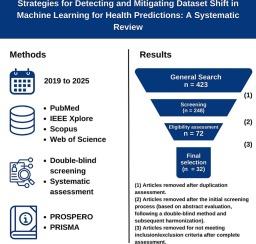用于健康预测的机器学习中检测和减轻数据集转移的策略:系统综述
IF 4.5
2区 医学
Q2 COMPUTER SCIENCE, INTERDISCIPLINARY APPLICATIONS
引用次数: 0
摘要
目的:本综述旨在对用于健康预测的机器学习(ML)应用中识别和纠正数据集移位的方法和技术的文献进行全面概述。方法系统检索PubMed、IEEE explore、Scopus和Web of Science,检索2019年1月1日至2025年3月15日之间发表的论文。搜索与机器学习、医疗保健和数据集转移相关的组合术语的字符串。共纳入了32项研究,并根据所处理的数据集移位类型、使用的检测和校正策略、算法选择以及对模型性能的影响进行了评估。结果该综述确定了广泛的数据集移位类型,其中时间移位和概念漂移是最常见的。基于模型的监测和统计测试是最常见的检测策略,而再训练和特征工程是主要的校正方法。大多数方法表现出适度的可解释性、计算可行性和通用性。然而,缺乏标准化的性能指标和外部验证限制了研究结果的可比性。虽然已经提出了几种有前途的方法来管理与健康相关的机器学习模型中的数据集转移,但没有一种方法可以在用例中广泛推广。这些技术在实际临床工作流程中的应用仍然有限。未来的研究应优先考虑前瞻性评估,亚组特定分析(例如,按种族,年龄或地理区域),并整合到临床决策支持系统中,以确保在医疗保健环境中稳健和公平的机器学习部署。提供了一个结构化的汇总表和概念管道图,以支持实际采用。本文章由计算机程序翻译,如有差异,请以英文原文为准。

Strategies for detecting and mitigating dataset shift in machine learning for health predictions: A systematic review
Objective
This review aims to provide a comprehensive overview of the literature on methods and techniques for identifying and correcting dataset shift in machine learning (ML) applications for health predictions.
Methods
A systematic search was conducted across PubMed, IEEE Xplore, Scopus, and Web of Science, targeting articles published between January 1, 2019, and March 15, 2025. earch strings combined terms related to machine learning, healthcare, and dataset shift. A total of 32 studies were included, and were evaluated based on dataset shift types addressed, detection and correction strategies used, algorithmic choices, and reported impacts on model performance.
Results
The review identified a wide range of dataset shift types, with temporal shift and concept drift being the most commonly addressed. Model-based monitoring and statistical tests were the most frequent detection strategies, while retraining and feature engineering were the predominant correction approaches. Most methods demonstrate moderate interpretability, computational feasibility, and generalizability. However, a lack of standardized performance metrics and external validations limited the comparability of results across studies.
Conclusion
While several promising approaches for managing dataset shift in health-related ML models have been proposed, no single method emerged as broadly generalizable across use cases. The implementation of these techniques in real-world clinical workflows remains limited. Future research should prioritize prospective evaluations, subgroup-specific analyses (e.g., by race, age, or geographic region), and integration into clinical decision-support systems to ensure robust and equitable ML deployment in healthcare settings. A structured summary table and conceptual pipeline diagram are provided to support practical adoption.
求助全文
通过发布文献求助,成功后即可免费获取论文全文。
去求助
来源期刊

Journal of Biomedical Informatics
医学-计算机:跨学科应用
CiteScore
8.90
自引率
6.70%
发文量
243
审稿时长
32 days
期刊介绍:
The Journal of Biomedical Informatics reflects a commitment to high-quality original research papers, reviews, and commentaries in the area of biomedical informatics methodology. Although we publish articles motivated by applications in the biomedical sciences (for example, clinical medicine, health care, population health, and translational bioinformatics), the journal emphasizes reports of new methodologies and techniques that have general applicability and that form the basis for the evolving science of biomedical informatics. Articles on medical devices; evaluations of implemented systems (including clinical trials of information technologies); or papers that provide insight into a biological process, a specific disease, or treatment options would generally be more suitable for publication in other venues. Papers on applications of signal processing and image analysis are often more suitable for biomedical engineering journals or other informatics journals, although we do publish papers that emphasize the information management and knowledge representation/modeling issues that arise in the storage and use of biological signals and images. System descriptions are welcome if they illustrate and substantiate the underlying methodology that is the principal focus of the report and an effort is made to address the generalizability and/or range of application of that methodology. Note also that, given the international nature of JBI, papers that deal with specific languages other than English, or with country-specific health systems or approaches, are acceptable for JBI only if they offer generalizable lessons that are relevant to the broad JBI readership, regardless of their country, language, culture, or health system.
 求助内容:
求助内容: 应助结果提醒方式:
应助结果提醒方式:


